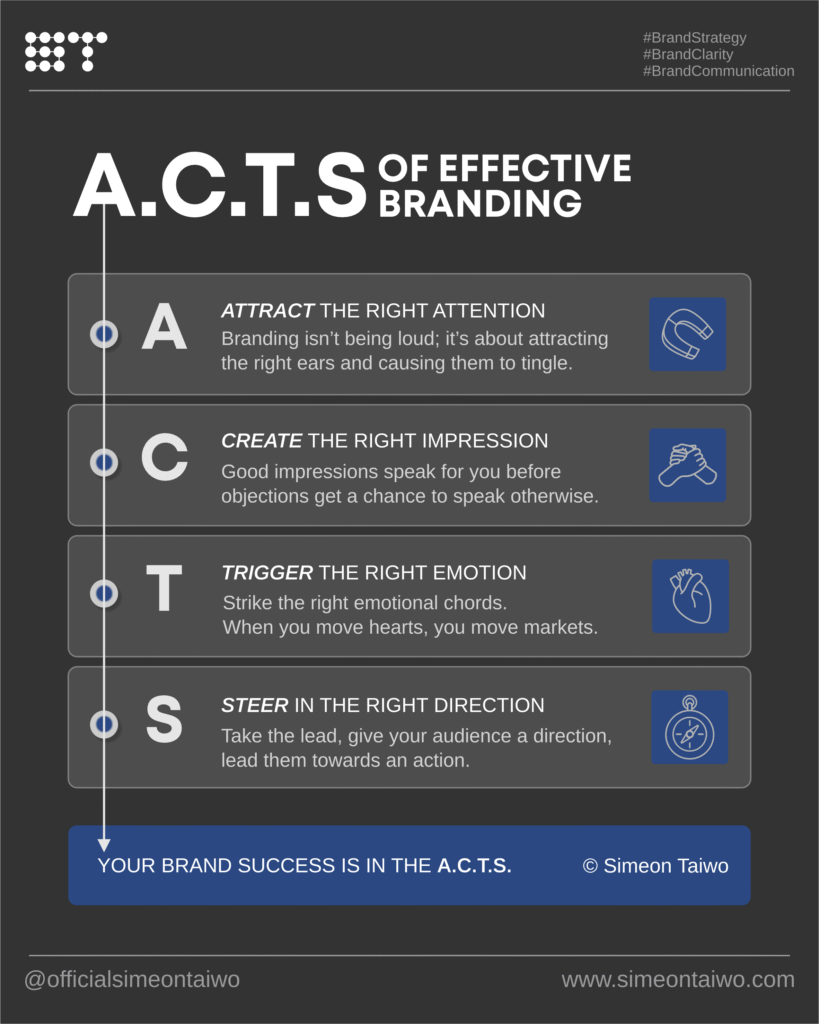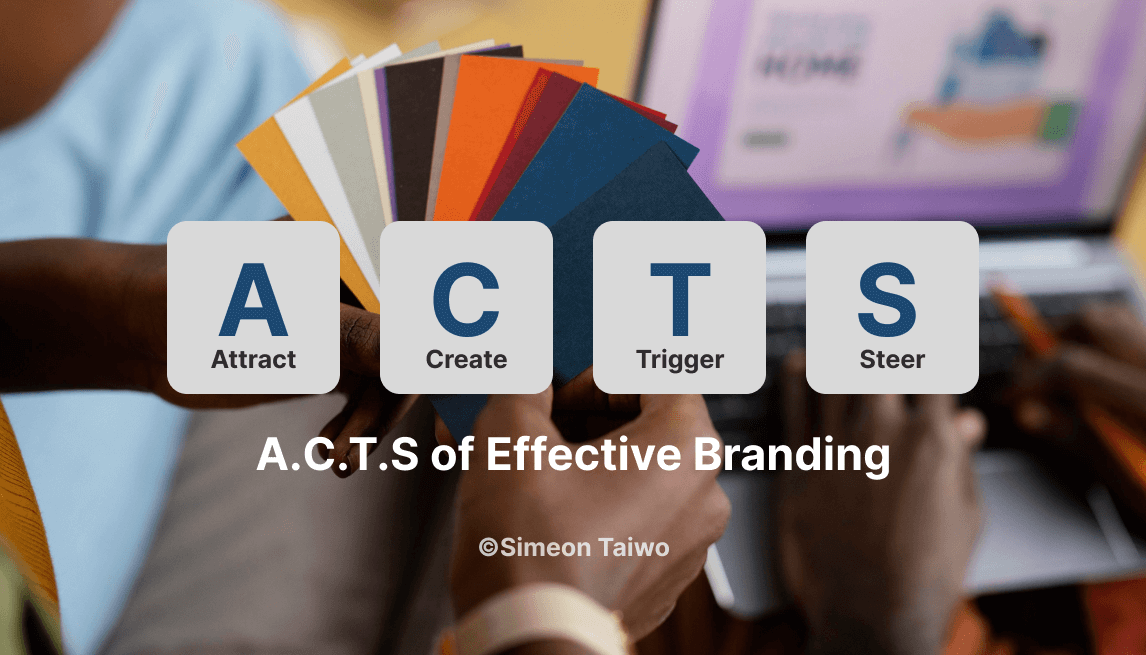In today’s saturated marketplace, effective branding isn’t a luxury; it’s a lifeline. From start-ups to established companies, the brands that stand out, sell more, and create lasting impressions are those that understand one simple principle: brand communication is a journey. That’s why I developed a practical, memorable, and powerful branding model—A.C.T.S. of Effective Branding.
The A.C.T.S Framework helps individuals and businesses craft brand messages that:
- Capture attention,
- Shape perception,
- Stir emotion, and
- Inspire action.
Let’s unpack each component and explore how it works for real-world impact.

A—Attracting the Right Attention
The first step in brand success is visibility. But not just any visibility—the right kind. If your brand is speaking to the wrong crowd or shouting into a void, it doesn’t matter how good your product is. We’ve seen brands that go viral for the wrong reasons. You don’t want attention that trends; you want attention that translates into trust. Imagine someone walks into a room and shouts, “Hey! Look at me!” Everyone glances, sure! But most will quickly go back to their conversations.
Now imagine someone enters quietly, dressed in a way that resonates with the people in that room, carrying something they clearly value. Heads turn, not because of volume, but because of alignment.
Attention isn’t accidental. It’s strategic.
To attract the right attention:
- Know your audience. Who do you want to reach? What do they care about?
- Position your value clearly. Why should they care?
- Stand out, but stay on-brand. Don’t just do trends—create signals that align with your unique voice.
Examples:
- A pharma brand can use a disruptive, aspirational promise to get the attention of its market.
- A spare part brand can leverage the fears of its market in an attention-grabbing advertisement.
- A fashion brand can use stories of self-esteem, acceptance, or prestige to get the attention of its target audience.
- A tourism brand can use simple but audacious aspirational promises to get instant attention from its target audience.
- A beverage brand can use bold messaging well displayed with high-contrast visuals on a large billboard to convey its brand promise to its target audience.
Key tools deployed:
- Color psychology
- Targeted messaging
- Consistent social media presence
- Brand storytelling teasers
If you don’t grab the right people’s attention, you don’t get a seat at the table.
C—Creating the Right Impression
Getting attention is half the job. The next is about what happens in the first 5 seconds—impression.
People will often decide if your brand is credible, valuable, or even worth their time in the blink of an eye. That decision is largely emotional, but it’s based on presentation. Think of a first date. You dress well, you speak with confidence, but if your behaviour, story, and energy don’t match your appearance, the person leaves feeling confused or underwhelmed. The same is true for your brand.
Ask yourself:
- Does your brand look the part?
- Do your visuals, tone, and experience match what you want people to think of you?
Creating the right impression is about alignment.
Your visuals, voice, and vibe should all tell the same story.
Common pitfalls:
- A luxury brand with poor photo quality
- A corporate brand using slang and memes that don’t fit
- A ministry brand using design that feels cold or generic
Instead, aim for:
- Clarity of your mission and tone
- Professional yet relatable design
- Authentic representation of your value
Every interaction should reinforce your core brand promise.
T—Triggering the Right Emotion
Brands don’t live in people’s heads—they live in people’s hearts.
Emotion is what turns a product into a movement. It’s what creates loyalty, advocacy, and word-of-mouth marketing. If people don’t feel something when they interact with your brand, they won’t remember it. People don’t buy with logic. They buy with emotion, then justify with logic. That’s because the part of the brain that influences their buy-in is the part that only processes pictures, not facts. This is why storytelling is the most potent tool when it comes to evoking the right emotions. Why? Stories help to create pictures in people’s minds, which in turn trigger corresponding emotions.
So, what kind of emotion does your brand evoke?
- Trust?
- Aspiration?
- Belonging?
- Safety?
- Excitement?
Storytelling is your most powerful tool here.
Tell your “why.” Share transformation. Show real faces. Use metaphors. Let people connect with the soul of your brand.
Tactics to apply:
- Emotional videos
- Relatable testimonials
- Powerful origin stories
- Empathetic messaging that meets a need
People may forget what you said, but they will never forget how your brand made them feel.
S—Steering in the Right Direction
A good brand doesn’t just evoke feeling—it gives direction. It leads. It inspires. It calls people to act or think differently. This is the part most brands skip, and it’s where the transformation happens. It’s not enough to make people feel something. You must lead them somewhere.
Imagine that you’ve caught someone’s attention, impressed them, moved them… and then you freeze. You don’t ask them to walk with you, buy, join, subscribe—nothing. That’s like inspiring someone in a speech and walking off the stage without telling them what to do next. Branding is leadership. Your brand must guide, influence, and direct them on a clear next step.
This is where branding becomes leadership.
Steering in the right direction means:
- Having a clear next step (buy, subscribe, share, sign up)
- Leading people through a transformation
- Taking a bold stand or shaping industry conversations
Examples:
- A leadership coach offering a free resource to spark transformation
- A fashion brand using its platform to promote sustainability
- A ministry brand creating content that leads people into purpose
Your content shouldn’t just say “look at me.” It should say “walk with me.”
This step turns brands into movements.
How to Apply the A.C.T.S Framework
To use this framework practically, ask yourself the following for every campaign, content piece, or touchpoint:
| A.C.T.S Component | Ask Yourself… |
|---|---|
| Attract | Who do I want to reach? How do I stand out authentically? |
| Create | What impression am I leaving? Is my presentation aligned? |
| Trigger | What emotion will this stir? Why should they care? |
| Steer | What’s the next step I want them to take? Where am I leading them? |
Whether you’re designing a landing page, posting on social media, or creating a pitch deck, ACTS is a framework you can deploy to help you stay strategic and connected.
🎯 Final Thoughts
The A.C.T.S of Effective Branding is more than just a framework—it’s a mindset. In a noisy world, brands that Attract, Create, Trigger, and Steer will rise above the noise and build something lasting.
It’s time to shift from accidental branding to intentional impact.
💬 “Don’t just build a brand. Build a brand that moves people.”
I remain your BrandCore Strategist.


